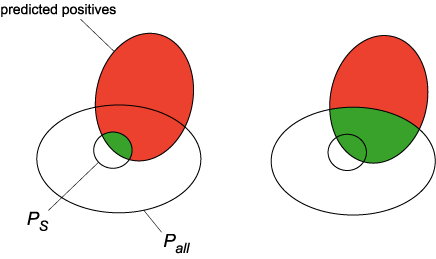
We only know a subset (Ps) of the full set of protein complexes in yeast (Pall), such as those represented in the MIPS complexes catalog. The left part of the figure illustrates the situation of predicting protein complexes and comparing them with Ps. Part of the predictions will agree with the known subset of interactions (true positives, shown in green), while part of it will represent interactions outside of this subset (false positives, shown in red). If all interactions in protein complexes were known, the number of true positives would be greater and the number of false positives smaller (shown on the right). Thus, false positives may either represent false predictions or newly discovered interactions. They are "false" in a classification sense, but not necessarily in a biological sense.